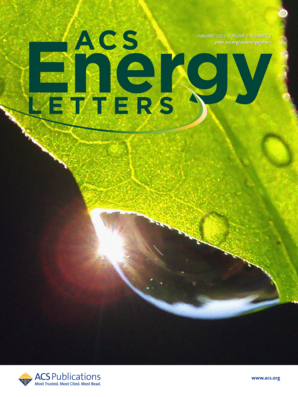从磁共振看卤化物包光体中的光诱导金属和顺磁缺陷
IF 18.2
1区 材料科学
Q1 CHEMISTRY, PHYSICAL
引用次数: 0
摘要
卤化物过氧化物是很有前途的下一代太阳能电池材料,但其在工作条件下,特别是在热、湿和光条件下的降解倾向阻碍了它们的商业化。要设计出更稳定的包晶材料,就必须识别降解产物,并在原子尺度上将它们与降解机制联系起来。在此,我们利用核磁共振(NMR)和电子顺磁共振(EPR)测量方法,使用磁共振方法识别和表征了光诱导的甲基卤化铅包晶石降解过程中金属铅团簇和 Pb3+ 缺陷的形成。1H NMR 共振的顺磁弛豫增强(PRE)证明了局部顺磁 Pb3+ 缺陷的存在,207Pb NMR 的大奈特位移证明了金属铅的存在,而它们的相对比例则由变温 EPR 中不同的温度依赖性决定。这项工作调和了以往文献中相互矛盾的结果,使人们能够利用 EPR 光谱来监测包晶器件的光降解。本文章由计算机程序翻译,如有差异,请以英文原文为准。

Light-Induced Metallic and Paramagnetic Defects in Halide Perovskites from Magnetic Resonance
Halide perovskites are promising next-generation solar cell materials, but their commercialization is hampered by their propensity to degrade under operating conditions, particularly under heat, humidity, and light. Identifying degradation products and linking them to the degradation mechanism at the atomic scale is necessary to design more stable perovskite materials. Here we use magnetic resonance methods to identify and characterize the formation of both metallic lead clusters and Pb3+ defects upon light-induced degradation of methylammonium lead halide perovskite using nuclear magnetic resonance (NMR) and electron paramagnetic resonance (EPR) measurements. Paramagnetic relaxation enhancement (PRE) of the 1H NMR resonances demonstrates the presence of localized paramagnetic Pb3+ defects, a large Knight shift of the 207Pb NMR proves the presence of lead metal, and their relative proportions are determined by the differing temperature dependence in variable-temperature EPR. This work reconciles previous conflicting literature results, enabling the use of EPR spectroscopy to monitor photodegradation of perovskite devices.
求助全文
通过发布文献求助,成功后即可免费获取论文全文。
去求助
来源期刊

ACS Energy Letters
Energy-Renewable Energy, Sustainability and the Environment
CiteScore
31.20
自引率
5.00%
发文量
469
审稿时长
1 months
期刊介绍:
ACS Energy Letters is a monthly journal that publishes papers reporting new scientific advances in energy research. The journal focuses on topics that are of interest to scientists working in the fundamental and applied sciences. Rapid publication is a central criterion for acceptance, and the journal is known for its quick publication times, with an average of 4-6 weeks from submission to web publication in As Soon As Publishable format.
ACS Energy Letters is ranked as the number one journal in the Web of Science Electrochemistry category. It also ranks within the top 10 journals for Physical Chemistry, Energy & Fuels, and Nanoscience & Nanotechnology.
The journal offers several types of articles, including Letters, Energy Express, Perspectives, Reviews, Editorials, Viewpoints and Energy Focus. Additionally, authors have the option to submit videos that summarize or support the information presented in a Perspective or Review article, which can be highlighted on the journal's website. ACS Energy Letters is abstracted and indexed in Chemical Abstracts Service/SciFinder, EBSCO-summon, PubMed, Web of Science, Scopus and Portico.
 求助内容:
求助内容: 应助结果提醒方式:
应助结果提醒方式:


